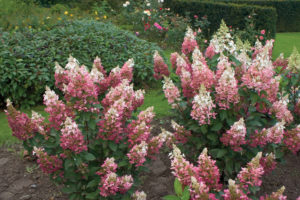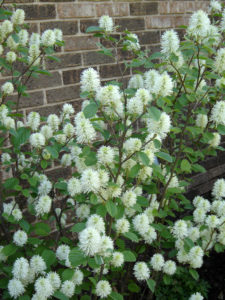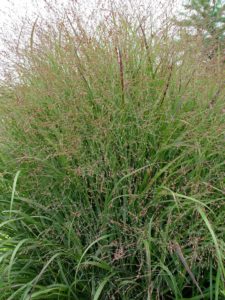12 Low-Care Plants You Probably Won’t Kill
March 20th, 2018
The first qualification on my new-plant list is that it’s not likely to die.
A dead plant isn’t a good plant in my mind – no matter how cool it looked in the garden-center pot or what kind of kudos it got in print.
If living is something you value in plants, too, here are 12 shrubs, evergreens and perennials I like that give really good survival odds, even under assorted forms of abuse.
1.) Panicle hydrangeas (Hydrangea paniculata). Superb new varieties are available in this type of cold-hardy, summer-blooming shrub with the white-to-pink cone-shaped flowers. Options range from 4- to 5-foot dwarf types such as Little Lime®, Bobo® and Little Quick Fire® to 7- to 8-footers such as ‘Limelight,’ Pinky Winky® and Quick Fire®. (Sun or part shade.)
2.) Spirea ‘Ogon’ (Mellow Yellow®) (Spirea thunbergii). This spring-flowering shrub looks more like a 5-foot, golden willow than a typical ball-shaped spirea. The leaves are narrow and finely textured and turn coppery in fall. Dainty, snow-white flowers cover the plant in early spring. (Sun or part shade.)
3.) Shrub roses. The 4-foot Knock Out® series is best known, but other types such as the lower-growing Drift®, Oso Easy®, Kolorscape® and Flower Carpet® series give a long bloom time in multiple color options with little care other than an annual or twice-a-year cutback. (Sun or light shade.)
4.) Fothergilla (Fothergilla gardenii or major). Sometimes called “witch alder,” fothergilla is a 4- to 6-foot, trouble-free, under-used native with early-spring, white, bottle-brush flowers and eye-popping red/gold/orange fall foliage. ‘Mt. Airy’ is a particularly good choice. (Shade or part shade.)
5.) Viburnum. It’s hard to go wrong with anything in this large family of flowering shrubs. Most viburnums get fragrant white spring flowers, bright fall foliage and fall fruits of differing colors. Some are native, and sizes range from 5 to 10 feet. (Sun to shade, depending on type.)
6.) Goldthread/greenthread falsecypress (Chamaecyparis pisifera). Here’s a tough conifer that has a shaggy habit with golden or green, lacy, soft foliage. Full-sized ones can grow upwards of 12 feet tall, while dwarf ‘Golden Mop’ stays closer to 5 or 6 feet tall and wide. (Sun or part shade.)
7.) Dwarf Hinoki cypress (Chamaecyparis obtusa). Many conifers are prone to bugs and diseases, but the Hinoki cypress clan is one of the most bullet-proof. Dwarf types are particularly useful in foundation plantings because of their slow growth and compact or narrow sizes. ‘Nana Gracilis’ (ultimately 8’ x 6’) is one of the best for flanking doorways or softening house corners. (Sun or part shade.)
8.) Blue holly (Ilex x meserveae). These evergreen hollies are bush types that can grow 8 or even 10 feet tall and wide but can be kept smaller. They slough off the butchering that yardeners often give them, and they usually grow through adversities, such as nearby tree roots, drought and occasional attacks of scale insects. Females like ‘Blue Princess,’ ‘Blue Girl’ and ‘China Girl’ even get nice red berries when pollinated by a suitable male. (Sun or part shade.)
9.) Switchgrass (Panicum virgatum). Switchgrass is a native ornamental grass that’s not picky about soil, growing both in hot, dry areas or cool, damp ones. The blades grow about 3 feet tall and turn burgundy in fall. The seed heads poke up another foot or so in summer and are dainty and pink/burgundy-tinted as opposed to plumes. ‘Northwind’ and ‘Dallas Blues’ are good blue-leafed varieties, while ‘Hanse Herms’ and ‘Shenandoah’ are green-leafers with some of the best fall foliage. (Sun.)
10.) Catmint (Nepeta). Despite the mint in the name, catmint doesn’t “run around” aggressively as spearmint and peppermint usually do. This 15- to 24-inch-tall perennial grows in gradually spreading clumps that bloom most of the season from June past frost, especially when cut back after the first flush of blooms fade. Flowers are blue, and leaves are grayish-green. This one is very heat- and drought-tough, too. ‘Walker’s Low’ is most popular, but ‘Kit Cat,’ ‘Blue Ice,’ ‘Cat’s Meow,’ ‘Cat’s Pajamas’ and Junior Walker™ are good shorter types. (Sun.)
11.) Sedum. This heat- and drought-tough perennial comes in pink-blooming bushy, upright plants 2 to 3 feet tall as well as gold- or burgundy-leafed, yellow-flowering creeping forms that hug the ground at 2 to 3 inches. The common trait is succulent leaves, which also make them non-favorites of deer and rodents. ‘Autumn Joy,’ ‘Autumn Fire,’ ‘Neon’ and ‘Brilliant’ are good uprights, while ‘Angelina,’ ‘Weihenstephaner Gold,’ ‘Fuldaglut’ and the SunSparkler series are good creepers. (Sun.)
12.) Liriope (Liriope muscari). Liriope or “lilyturf” is a perennial flower masquerading as a grass. The clumps of foot-tall blades send up purple-flowered spikes in late summer and stay green through most winters. Just weed-whack the foliage down to a stub at the end of each winter and that’s it for care. (Sun, shade and everything between, including dry shade and tree roots.)










